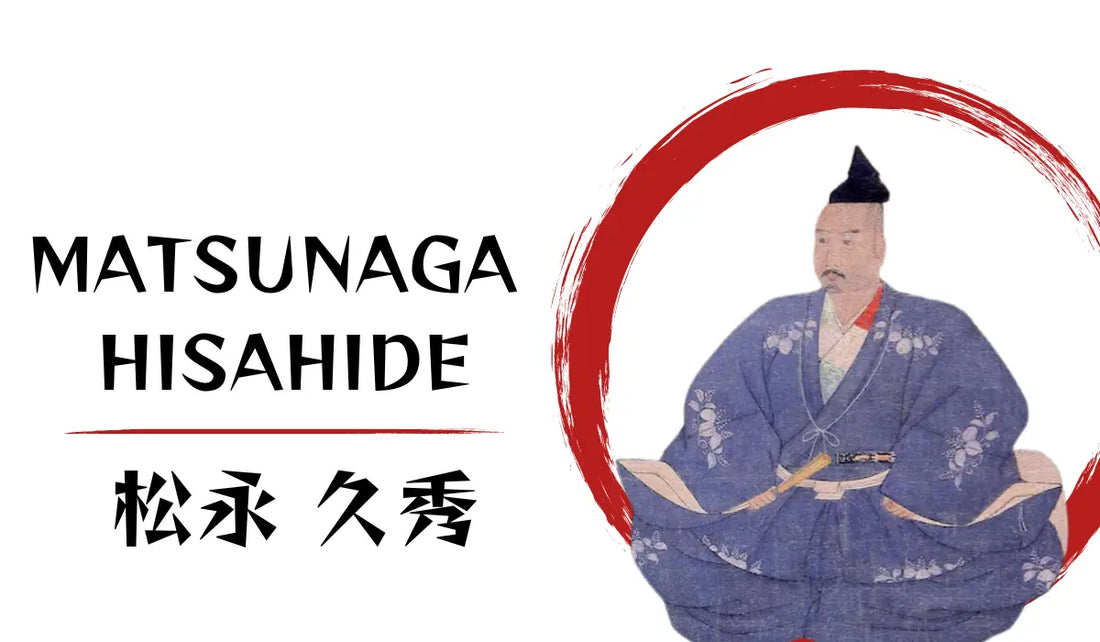
Matsunaga Hisahide
Share
Matsunaga Hisahide (松永 久秀; 1508 - November 19, 1577) was a Japanese daimyō of the Sengoku period.
Matsunaga Hisahide Biography
A companion of Miyoshi Nagayoshi since childhood, Hisahide first appears in 1549, when he assisted Nagayoshi in defeating Miyoshi Masanaga and served as a spokesman in Kyoto (he first appears as a Miyoshi servant in official documents in 1541).
During the 1550s Matsunaga was the representative of the Miyoshi clan to the Imperial capital and remained close to the shōgun Ashikaga Yoshiteru. Hisahide was later charged with the conquest of Yamato province, a feat that made him, in 1564, essentially an independent daimyō.
However, Matsunaga was already working secretly to eliminate Nagayoshi; between 1561 and 1564, three of Nagayoshi's brothers and his heir died. Matsunaga Kazunari (1561) and Matsunaga Jikkyu (1562) died under what could be considered mysterious circumstances while Atagi Fuyuyasu (1564) was assassinated.
In 1563 Nagayoshi's son and heir, Yoshioki also died under mysterious circumstances. The extent to which Hisahide had any role in this will never really be known, but it is said that Yoshioki was poisoned. Also, some said that he pushed Nagayoshi to kill Fuyuyasu.
Regardless of how bloody his hands were Matsunaga was essentially the heir to Nagayoshi's kingdom when the latter died in August 1564. In fact, Nagayoshi had adopted the young Miyoshi Yoshitsugu as heir after Yoshioki's death, and this young man was currently under the tutelage of the so-called Miyoshi triumvirate:
Miyoshi Nagayuki, Miyoshi Masayasu, and Iwanari Tomomichi, who resided in Sakai, the Miyoshi clan's headquarters in Settsu Province. Although disagreements existed between the triumvirate and Hisahide, for the time being they acted in unison.
Shōgun Yoshiteru had recently attempted to free himself from the influence of the Miyoshi clan to which he had been subjected for years; his efforts for independence cost him his life.
On June 17, 1565, troops sent by Matsunaga and the Miyoshi clan closed in on the shogun's palace and forced Yoshiteru to commit suicide after a heroic struggle. In his place was put the newborn Yoshihide, an act that prompted Yoshiteru's brother Yoshiaki to flee and seek help.
Meanwhile, relations between Matsunaga and the Miyoshi clan deteriorated and began to fight. In 1566 Matsunaga's warriors were defeated outside Sakai, and Hisahide himself failed in his attempts some time later to reduce the Miyoshi clan's presence in Kawachi province.
A truce was arranged that allowed Hisahide to leave the Sakai area, and fighting continued inland. During the conflict Hisahide became famous for having burned the Great Hall of the Buddha of the temple of Tōdai-ji. To this day, this act is still considered an unnecessary act of evil.
In 1568 Yoshiaki obtained the support of Oda Nobunaga; in November 1568 Nobunaga marched on Kyoto. Faced with this unexpected danger Hisahide decided to submit and was allowed to keep his lands in Yamato province.
Most likely for Nobunaga, Hisahide was a useful tool both against the Miyoshi clan and to expand the influence of the Oda clan in Yamato province. In addition, Matsunaga had sent as a sign of his sincerity, a well-known tea object known as Tsukumogami, a gesture that undoubtedly impressed Nobunaga.
Matsunaga proved useful in the following years, serving Nobunaga in his wars against the Azai and Asakura clans and, of course, the Miyoshi.
In 1573, however, Matsunaga conspired against Nobunaga himself along with, of all the enemies the Oda had, Miyoshi Yoshitsugu. This arrangement did not last long, and soon Hisahide was back on Nobunaga's side, helping to destroy Yoshitsugu and what was left of the Miyoshi clan. Hisahide was then involved in the siege of Ichijōdani.
In 1577 Hisahide rebelled again; he and his son Hisamichi abandoned their positions around Honganji and returned to Yamato province, perhaps hoping that other daimyō, including Tsutsui Junkei, would follow them.
This did not happen, and Junkei, with Oda Nobutada, soon surrounded Hisahide in Shigi Castle and laid siege to it. Word came that Nobunaga wanted two things from Hisahide: his head and a certain precious tea object called Hiragumo which Hisahide destroyed before killing himself. Hisamichi also committed suicide.
Matsunaga Hisahide, at once a great conspirator and a man of culture, embodied to some extent the spirit of the sixteenth century, though largely for the worst qualities of that period.
His dark plots and the manner in which he died (in addition to destroying the object of tea, it is said that he ordered his head blown off so the Oda would not have it) became recurring themes in tales of the Edo period.
An ardent follower of Nichiren, Hisahide was also vilified in contemporary Western accounts, especially after he banished the Jesuits from Kyoto in 1565.

